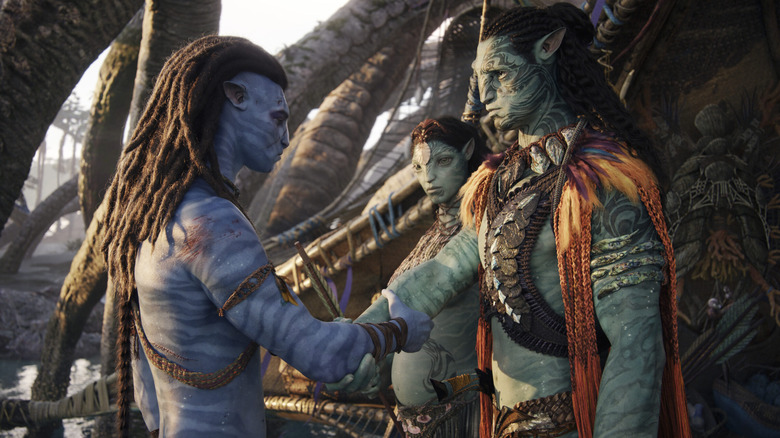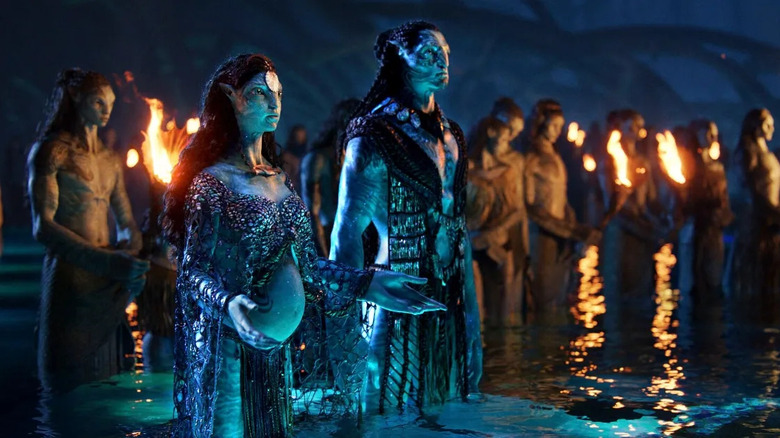Is Avatar: The Way Of Water's High Frame Rate The Future Of Cinema?
13 years in the making, James Cameron's new film "Avatar: The Way of Water" is, true to the filmmaker's ethos, a technical marvel of the highest order. Set on a distant alien moon, the film is about a war between the honorable, nature-loving Na'vi and a cadre of vengeful human super-Marines who team up with evil whalers to hunt down the film's protagonists. The Na'vi are nine-foot tall, blue-skinned, large-eyed creatures, and are visually realized with advanced motion-capture technology. Actors like Sam Worthington, Zoe Saldaña, Cliff Curtis, Sigourney Weaver, and others have all been digitally interpolated to look like enormous aliens, and the effect is uncanny. Cameron also famously filmed many of his actors underwater to give them the proper movements and to experiment with how far he could push effects.
Most notoriously, however, Cameron also shot several "The Way of Water" sequences in 48 frames per second, a format that has been tried by multiple blockbusters in the past, largely to rejected results. Infamously, Peter Jackson shot his three "Hobbit" movies in high frame rates, and no one seemed to step forward in its defense. In 2019, /Film wrote about how Jackson, as well as "Gemini Man" director Ang Lee, were pushing a format that had no future. After over a century of seeing films at 24 fps, audiences weren't yet ready to accept a format that was more often used by video games and news broadcasts.
"The Way of Water," however, is poised to be one of the biggest films of all time. And if a high frame rate film can make a billion dollars, then it may be time to consider that the industry may finally be pointed earnestly in that direction. Love it or hate it, 48 fps may be the way of the future.
Film projector technology
And not just because of its aesthetics. Technology may be changing too fast to accommodate average frame rates.
A brief rundown. In the days before sound, film projectors didn't necessarily run at 24 fps as a standard. In some cases, early projectors were hand-cranked, leaving the actual frame-rate in the able hands of the projectionist. Silent films were usually filmed at about 16 fps and then projected at about 20, making for that "sped-up" look a viewer might see in older movies. It wasn't until the invention of synchronized sound that a standard needed to be set. 24 frames was the lowest number a studio could get away with and still retain a reasonably realistic illusion of movement. The standard modern audiences are used to was pioneered for reasons of thrift.
With the advent of video cassettes and, later, digital cameras, filming in different frame rates became more common. News broadcasts filmed in 36 fps, for instance. In so doing, audiences became trained to see that look as TV-related. As video games advanced, so too did digital frame rate alterations, and most modern games are now presented with 60 fps. When a film came along that also tried 60 fps, however, audiences complained that they looked too much like games.
Films, then, tried to hold steady at 24 fps. In 2022, however, a schism has appeared in the technology used to shoot films and the technology used to present it. As new digital projectors can handle more and more information, they begin butting up against the traditional century-old flicker of 35mm film. This is causing a visual "judder" in presentation, as when the image seems to "shimmer" as a camera pans horizontally across a scene.
Is it a new thing, or is it the next 3D?
The best way to correct this judder is by adding frames. There will be no visual "skip," if there's more information on screen in between the skips.
The above-mentioned tech-forward filmmakers seem to sense that this is the next step in cinema's visual evolution. Audiences may be largely skeptical at the moment, but this author is old enough to remember the 2002 film "Star Wars: Episode II – Attack of the Clones." Although not the first film to presented in theaters digitally, it was the first high-profile blockbuster to do so. At the time, digital projection looked pretty terrible. The movement was ineffably indistinct, the images milky, the dark and black scenes filled with digital "fuzz" particles. It seemed that digital projection had a long way to go.
20 years on, one is hard-pressed to find a theater that is 35mm-equipped at all.
High frame rates have already improved since "The Hobbit," and companies like TrueCut Motion — using an advanced smoothing technology — are working to make the format look more acceptably cinematic for modern audiences. "Avatar: The Way of Water" still has a notably distracting "smoothness" in its 48 fps scenes, and many audiences may still bristle at the notion. But with a film as enormous as "Avatar," it may be that the future of cinema will incorporate that look. At the very least, many filmmakers and audiences may have to stop and consider a future where high frame rates eventually become new standard frame rates.
Of course, some pundits claimed that 3D tech was here to stay when the first "Avatar" came out in 2009. 3D films, of course, eventually petered out. HFR, however, seems to have an edge over 3D. It is no gimmick. It is a matter of presentation.


